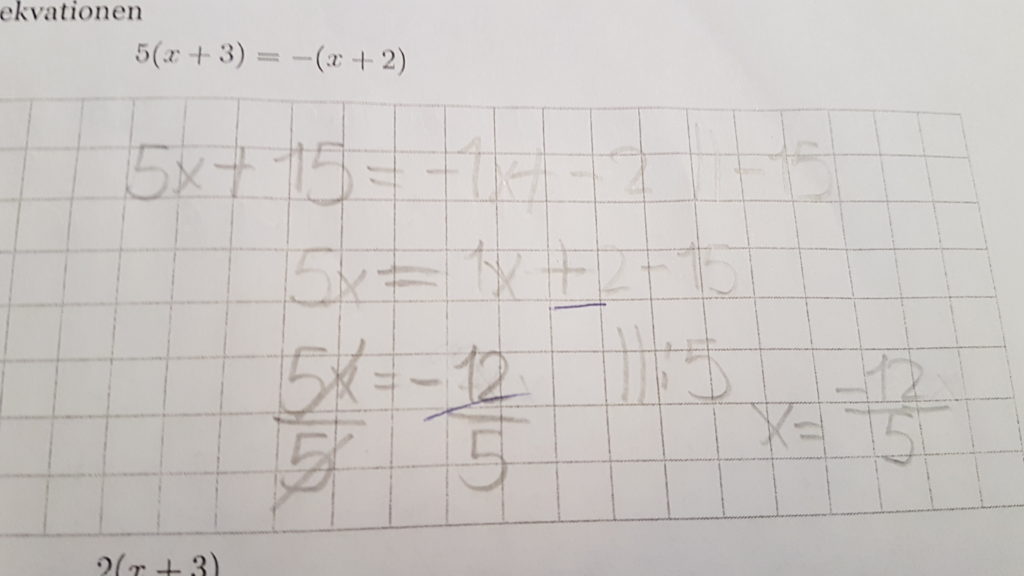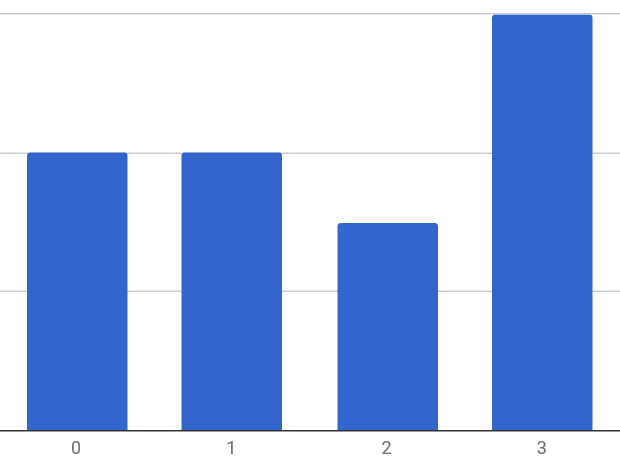This year my students in grade seven have not had any standard tests. The reasons for this can be read in part 1 and how they are graded can be read in part 2. I wish that you take the time to read those before you continue. One year is enough time to start seeing if the methods that are used in the learning process are working or not. The main focus in grade seven has always been to ensure that the students have a solid foundation in arithmetics and algebra. Therefore the last test that I have had in grade seven has always been equations.
I have already showed in part 7 and in part 8 that the way we have worked this year has had a positive effect on the students’ interest for mathematics. Now the question is if not having standard tests ensures that the students learn mathematics and that they still are able to perform on tests. To examine this I have saved results from the test on equations during many years back, and I will analyze and compare this year’s results to previous years’.
Here is some background information:
In 2014-2015 I had 48 students divided in three classes. The teaching methods and the system of grading differed a lot from that year to recent years. I had no whiteboards in the classroom, nor did the digital matrix for grading students exist. The lack of equipment and proper tools for grading led to more traditional teaching and therefore the grades were mainly based on test results.
(Click here to read about the methods and benefits of the whiteboards we are using today in our classroom).
During 2015-2016 I had 28 students in grade seven divided in two classes. The teaching methods were the same as previous year.
In 2016-2017 I had 33 students divided in two classes. The methods for teaching and grading these students took a big leap forward that year since I received whiteboards for the students to work on, and the digital matrix for grading students was finished. The students’ grade consisted of 50% “lesson activity” and 50% test results.
These improvements led to a much nicer atmosphere in the classroom but also to greater results. The responses from the students were encouraging, to say the least. They really enjoyed collaborating and exploring mathematics on the whiteboards and they also said that they loved being graded based on their lesson activity (this is something that teachers strive to do but how it is done is often quite vague. With the digital matrix it is completely obvious for the students how their activity affects their grade).
This year 2017-2018 I started with 53 students divided in three classes. As I have mentioned throughout this series, the goal is to create a learning environment where the students learn important competences, but at the same time it is important that they develop an interest for mathematics. I continued doing things from last year that supported this but I also removed things that counteracted this, which I believe to be standard tests. As I have already shown, all that has been done this year has been a success in the aspect of waking the students’ interest in mathematics.
Now let’s move on to the test in equations. If you are curious to what it looks like and how it is graded, then here you go:
Instructions for grading the test.
I will do my best to present results without violating any rules or the trust of my students. Since this is no drama show, I will start with presenting what I find to be the most important finding, which is how different teaching methods affects the boys’ results. This is important since PISA have shown that boys in Finland have been performing poorly in mathematics in recent years, so obviously we need to find a solution for this.
In this test of equations the boys have had the following averages (scale from 4-10):
2015: 6,57
2016: 7,07
2017: 7,64
2018: 7,43
It is interesting to notice how much better the boys have performed in the last two years when the teaching style and the grading system has been different. Even though there can be huge variations from year to year I strongly believe that by activating the students and letting them explore mathematics, while at the same time giving them constant feedback with the help of the digital grading matrix, is beneficial for the boys compared to traditional teaching. This does in no way mean that girls would have a disadvantage using these methods. The girls still hold the record in 2017 with an average of 8,16.
This year we did not manage to beat the results from last year, which in all honesty would have been fun to do, but learning is not a competition. I was also careful in not trying to prepare the students for the test with anything out of the ordinary, in order to achieve accurate results. But we also had some unfortunate setbacks this year. The biggest setback was that we were plagued with flus. The absence of the students has been record high, which of course has had a negative effect on learning. The worst time was around december-mars where it was normal to have three or even four students absent every lesson. This made me keep count of the amount of lessons the students were absent when learning equations. The top 5 amount of absent lessons when learning equations were: 32%, 24%, 24%, 24% and 16%. This is just too much.
But with all of this said let’s analyze the results further. In order to present the results I have grouped the grades into four categories. The grades used in Finnish schools are 4-10. I represent grade 4 with 0, grades 5 and 6 with 1, grades 7 and 8 with 2 and grades 9 and 10 with 3.
This is the distribution of the grades in the class with the highest average:
These are great results, so not having tests throughout the year has obviously not had any negative effect on these students’ skills in mathematics. Therefore I will just move on to the distribution of the class with the lowest average:
This is where it gets interesting. As you can see there were many students who performed well in this class, so now I am only interested to examine the students who scored low points. This is where the grade from this test actually lies about the students’ performance. When you watch the pictures below of some of the calculations made by these students, you will understand what I mean.
 |
 |
 |
 |
 |
 |
Obviously they have learned strategies to solve equations, but they made too many arithmetical mistakes in order to achieve a good grade. But even with all of these mistakes, they managed to get 25-35% of the points in this test. This means that they just need more routine, so I am not worried about this. They have learned enough to be able to continue their studies, and if they work hard their skills will improve. But here is the thing though; they need to have the motivation to continue working.
Out of experience I know that if I would have tested these students throughout the year, there is an imminent risk that they would have performed poorly on all of them. It does not take much to make young students lose confidence and stop trying due to lack of motivation, and failing at tests is certainly an efficient way of doing this.
I have watched these students for a year and so I have seen them gradually making progress and even started to enjoy mathematics. Most of them have put a lot of effort into their homework and worked hard during lessons, so I can ask no more of them. My job is now to make sure that they have the motivation to continue working, and after two more years we will see how far they go.
Conclusion
It has now been a year without tests for my students. What effect has it had? As I have shown, students still achieve good results on tests and the interest for mathematics has improved. The students are working during lessons and the majority of the students put great effort into their homework. Having experienced the atmosphere in the classroom I can tell you that it is truly wonderful. It does not matter if the students are gifted in mathematics or if they find it difficult. They enjoy coming to the lessons and we are working together to ensure that everyone learns.
Personally I have always wanted to become a teacher who is a mentor and a source of inspiration for my students, and this year it truly feels like I have accomplished this. I have enjoyed working with my students more this year than ever before, so what is my answer to “are tests necessary?”; They absolutely are not.
Are you interested in learning more about the digital math book we are using that makes all of this possible? Then please visit Ma.fi (available in English, Swedish and Finnish)

